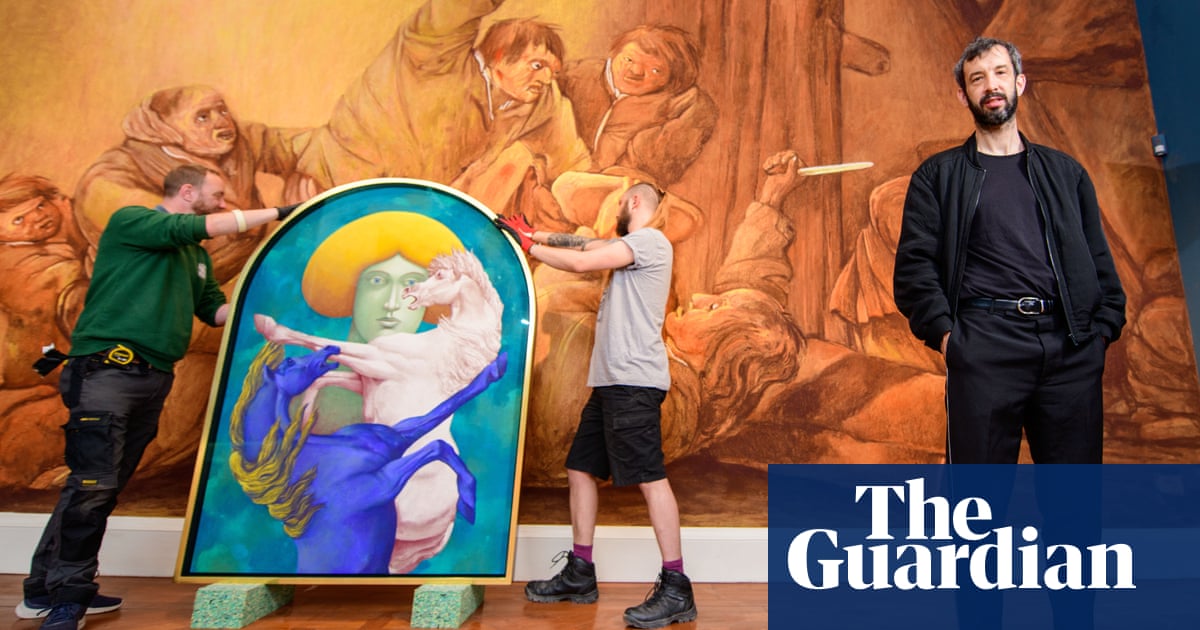There was a time when Nicolas Party would be pursued by police for decorating trains and buildings across Europe with his distinctive street art. Now, grand galleries and museums invite him to unleash his visions on their walls.
His latest extraordinary piece, a large mural in soft pastel inspired by the works of a 17th-century Dutch artist and an 18th-century British master has materialised at theHolburne Museumin Bath.
As the finishing touches were being put to the work, Party said he was thrilled that the Holburne, housed in a late-18th-century building and the custodian of paintings by the likes of Thomas Gainsborough and George Stubbs, was hosting his work. “It’s great to be in a grand place like this.”
For his new piece,his first major mural in an English gallery, Party borrowed from a small oil painting in the Holburne’s collection, A Brawl Between Peasants, by Benjamin Gerritsz. Cuyp, a Dutch painter known for his allegorical oil panels and landscapes, influenced by Rembrandt.
Over four days he recreated the rather violent image over a whole wall of a gallery, raising an awful lot of pastel dust.
He used pastels again for a second, smaller work, this time on linen – a depiction of two horses in the style of Stubbs’s horse and lion paintings, with a calm, ghostly human face between them.
The second work was then hung at the centre of the mural, obscuring much of the action. Party’s mural is called A Brawl Between Peasants, After Benjamin Gerritsz, 2025. The second, smaller piece is Portrait With Two Horses,2025.
The artist said he was drawn to the Dutch painting because he liked the “grim, funny” subject matter. “It’s not a portrait or a sweet landscape, it’s more unusual.” The mural is a close copy and Party said the addition of the second element – the horses and face image – made it his work.
It didn’t worry him that the most dramatic part of the mural was hidden behind the smaller image, he said. “I think my work becomes my work when I put the two together.”
A chamber had to be built in front of the wall for Party to work in. The wall has to be prepared with acrylic paint, water and sawdust to create a sandpapery texture that holds the pastel.
Sign up toArt Weekly
Your weekly art world round-up, sketching out all the biggest stories, scandals and exhibitions
after newsletter promotion
“So that makes a little mess and the pastel generates a lot of dust. That’s why we have to be enclosed.” He then uses both hands, applying the pastel and rubbing it to create textures and colours. “It’s quite tiring so I use both arms.”
The piece is the showstopper in an exhibition called Nicolas Party: Copper & Dust, which features two rooms of smaller works including striking landscapes, still lifes and portraits, created out of oil on copper.
Chris Stephens, the director of the Holburne, said the gallery was excited to show Party’s work. “With his deep knowledge of the history of art, especially his interest in 17th-century Dutch painting and in 18th-century pastels, both of which feature in the Holburne’s collection, Nicolas’s art is in a perfect setting.”
Nicolas Party: Copper & Dust, runs from 12 May until 31 August.
